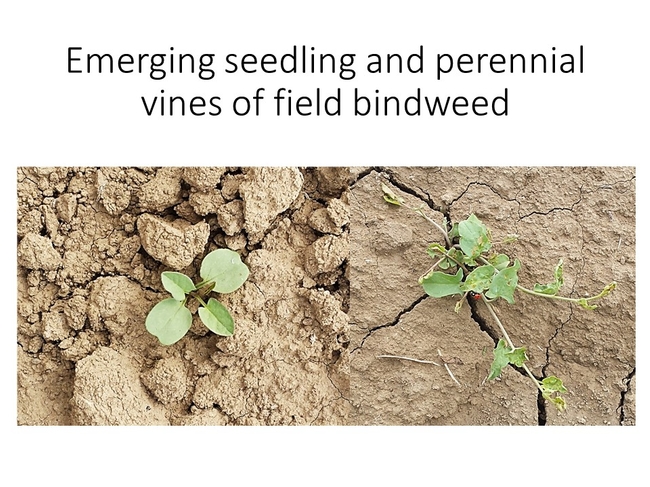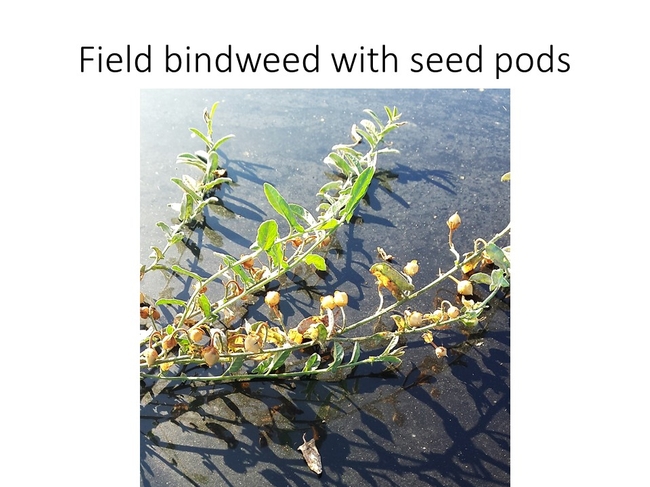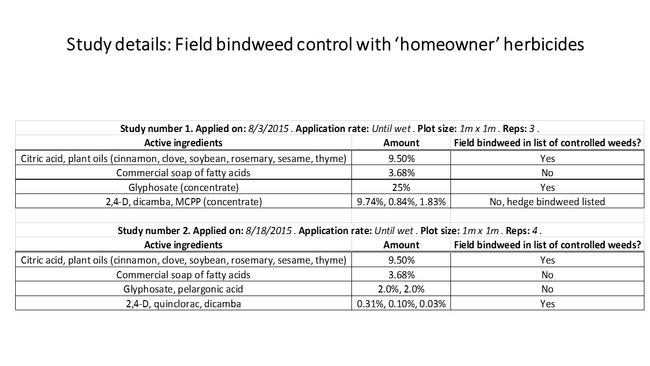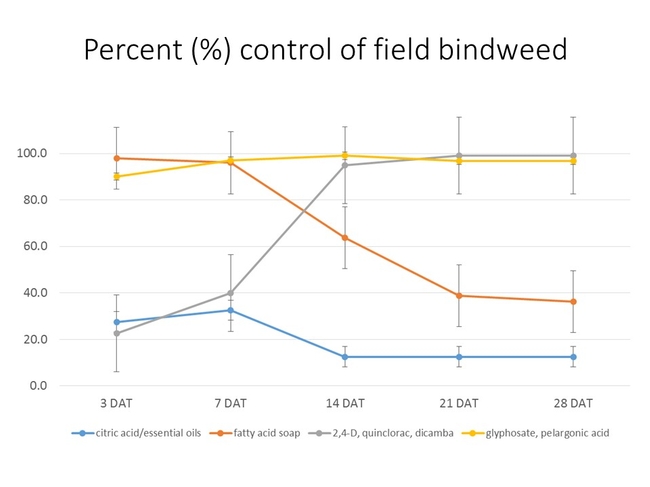In a recent blog post, Dr. Clyde Elmore discussed weed species changes in urban environments in response to the ongoing drought. One weed that can thrive under dry conditions is field bindweed, a significant weedy pest for homeowners, land managers, and farmers, alike.
NOMENCLATURE:
Field bindweed was first named by Linnaeus in 1753; its Latin binomial (Convolvulus arvensis) is derived from convolvere ("to roll together") and arvense ("in the field"). Which is pretty appropriate, if you ask me.
BINDWEED BIOLOGY
Field bindweed is a persistent perennial in temperate climates that can colonize a multitude of habitats including: roadsides, railways, pastures, cultivated fields, orchards and vineyards, lawns, and home gardens. Emerging vines may arise from germinated seeds (as evidenced by the presence of cotyledons, which are almost square but for rounded edges) or from underground stems called rhizomes (no seed leaves are present) (Figure 1). Field bindweed leaves average between 1/2 and 2 inches in length, are alternately arranged along the vine, and are arrowhead-shaped. The species displays some plasticity with respect to the growing environment; under ideal conditions, the leaves (and vines) will be larger and more robust than they might appear during times of drought. The vines are typically prostrate, although they will grow and twine up through flowers, crops, and shrubs.
Figure 1. Field bindweed seedling emerging (left) as compared to a vine emerging from over-wintering rhizomes.
Flowers are trumpet-shaped (resulting from the fusion of five petals) and are about 1 inch in diameter. Flowers are white to pink in coloration and last for a single day. Fun fact: a related species, Convolvulus tricolor, was included in Linneaus' flower clock. To find out more, do an Internet search for 'flower clock', 'circadian rhythm', and/or 'chronobiology'. Field bindweed seeds are produced in papery capsules with an average plant producing between 500 to 600 seeds (Figure 2). Individual seeds are 3-sided, brown to grey in color, and have hard, impermeable coats. This mechanically enforced dormancy ensures that seeds can survive for many years in soil.
Figure 2. Rounded capsules containing between 1 and 4 field bindweed seeds, each, along the length of a vine.
Field bindweed is less affected (than many other species) by drought conditions due to its deep and extensive root system. Although the majority of the species' lateral roots and rhizomes are found in the upper two feet of the soil surface, some vertical roots can extend to depths of 10 to 20 feet, or more.
Field bindweed can be easily mistaken for other closely related species, including: hedge bindweed (Calystegia sepium), wild buckwheat (Polygonum convolvulus) and numerous morningglory species (Ipomoea spp.). For more information regarding species identification/discrimination, please see the following websites:
King County, WA: http://www.kingcounty.gov/environment/animalsAndPlants/noxious-weeds/weed-identification/field-bindweed.aspx
Oregon State University: http://oregonstate.edu/dept/nursery-weeds/feature_articles/vines/vine_weeds.html
UC IPM: http://www.ipm.ucdavis.edu/PMG/WEEDS/morningglories.html
BINDWEED MANAGEMENT
Anyone who has attempted to manage field bindweed knows that the efficacy of any strategy (chemical, cultural, and physical) is dependent upon the size of your infestation, as well as the magnitude of your patience. The UC IPM webpage provides advice regarding field bindweed control. It is well worth a review.
In August/September 2015, we conducted two small studies to look at the efficacy of 'homeowner' or 'off the shelf' herbicides on field bindweed suppression (Figure 3). The herbicides included: 1) a mixture of citric acid and plant oils, 2) a soap of fatty acids, 3) glyphosate/glyphosate-based product, and a 4) mixture of auxinic active ingredients. All of the products were purchased at a local hardware store and, with the exception of two concentrates that required dilution, all were 'ready to use' (RTU). The glyphosate and 2,4-D/dicamba/MCPP products in Study 1 were diluted to 1 oz and 4.5 oz product/gallon, respectively. All of the products were applied to emerged bindweed vines (which were flowering at the time of application). Plants were treated 'until wet' (as suggested on the product labels), meaning that the herbicide solutions were beginning to run off of the leaves; none of the products provided soil-based residual/extended weed control.
Figure 3. Details about the two studies conducted in 2015 to evaluate RTU herbicides for field bindweed control.
Results are presented in Figures 4 and 5. In both studies the citric acid/essential oil mixture did not control perennial field bindweed more than 50% for up to 28 days after treatment (DAT). Although the fatty acid mixture controlled field bindweed 99% at 3 DAT, control dropped to 35% to 40% by 28 DAT. Both the citric acid/essential oil and fatty acid herbicides are considered 'contact' products, meaning that they are only active against the plant tissue that they come into contact with. In essence, these products burned only the green leaf and stem tissue that they were applied to. While these contact herbicides are likely to be effective at managing bindweed seedlings, perennial vines can draw upon stored root reserves and re-sprout.
The glyphosate and auxinic herbicide-based products acted more slowly (because of their systemic nature), but provided 99% control of field bindweed at 28 DAT. The one exception was the glyphosate-pelargonic acid herbicide in study number 2; although glyphosate must be translocated to its site of action before control can occur, pelargonic acid is a contact herbicide (hence the rapid burndown). Systemic herbicides are more likely to provide 'long-term' control of perennial weeds as these products will be moved away from the treated foliage and dispersed throughout the treated plants. For example, glyphosate is translocated to all growing points (i.e. both shoort and roots), where it interferes with amino acid synthesis; as a consequence, field bindweed treated with glyphosate will regenerate/recover more slowly.
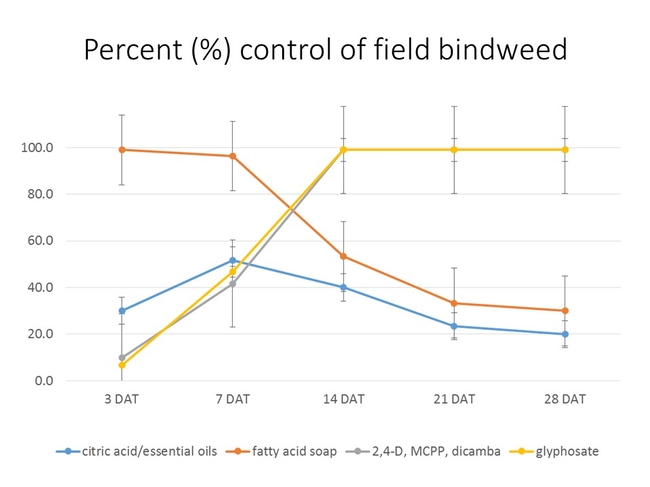
Figure 5. Field bindweed control in study 2 from 3 DAT to 28 DAT.The blue line represents the citric acid/essential oil product, the orange line represents the fatty acid soap, the grey line represents the 2,4-D/dicamba/quinclorac herbicide, and the yellow represents glyphosate/pelargonic acid.
HERBICIDE PERFORMANCE AND SAFETY
Before choosing a herbicide, be sure to understand how and for how long the products will work. For perennial weeds, systemic herbicides will likely provide greater/longer suppression than contact products, although it is reasonable to expect that a single application may be insufficient for complete control. This is an important point to remember: herbicides are not always 100% effective. Herbicides may fail for many reasons including: poor spray coverage on large weeds, applications to stressed weeds, herbicide wash off, use of an ineffective active ingredient against the target species, etc. Herbicides, if used improperly, can cause damage to desirable species; anyone using herbicides should be aware of their selectivity and the conditions that can induce spray drift or volatility. And, as always, people using herbicides should be mindful to follow ALL instructions listed on the labels to ensure the safety of themselves, their family and pets, and the environment.
